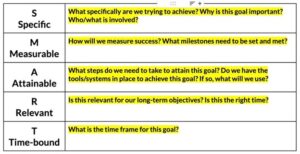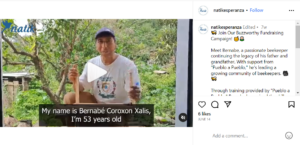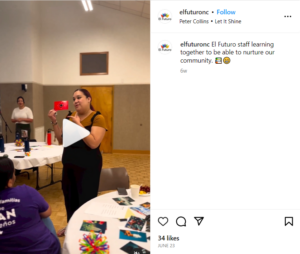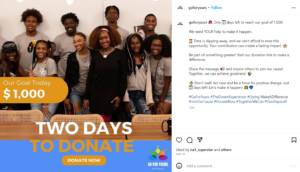6 steps to creating a nonprofit year-end and GivingTuesday social media strategy
In today’s digital age, social media has emerged as a powerful tool for nonprofits to reach wider audiences, build engagement, and drive donations. As GivingTuesday and year-end fundraising season approach, having a well-thought-out social media strategy aimed at your target audience becomes crucial for nonprofit organizations aiming to maximize their impact.
In this blog, we will outline a step-by-step guide on how to develop an effective social media strategy for GivingTuesday and year-end campaigns, along with suggestions for various types of posts to inspire and mobilize supporters across different social platforms.
Why does year-end differ from any other social strategy?
GivingTuesday is a global movement focused on charitable giving, and year-end is a key time for nonprofit fundraising with 30% of charitable giving taking place in December and 10% occurring in the last three days of the year. . Unlike your regular social media strategy that may cover a broader range of topics and initiatives, GivingTuesday and year-end center exclusively on inspiring generosity and encouraging people to support your cause.
Because year-end only occurs for a limited time, it is important to do extra planning to ensure that your nonprofit can maximize its impact within that time frame. Another thing to consider is urgency and how people respond to it. If you were to see a sale that lasted for two months you might not be encouraged to purchase right then and there. But If you see the sale ends in one or two days, you might be encouraged to make a purchase sooner. This goes for donations, too! If supporters see that there is only a limited time to hit a donation goal, and see it over and over on social media, then they may be more likely to donate.
Embracing GivingTuesday and year-end campaigns through social media can ignite giving spirits, make a significant impact, and drive positive change.
Step 1: Set clear goals and objectives.
The first step in developing a successful social media strategy is setting clear and measurable goals. Determine what you want to achieve through your GivingTuesday and year-end fundraising campaigns. Whether it’s increasing the number of donors, meeting a specific fundraising target, or boosting brand awareness, having well-defined goals will guide your entire social media approach.
Try using the SMART goal table to define and specify your measurable goals!
Step 2: Know your audience.
Understanding your target audience is essential to tailoring your message and content. Analyze your current supporter base and identify potential demographics that resonate with your cause. Different social media platforms attract diverse audiences, so consider where your target audience is most active and create content accordingly. Below is a general breakdown of the audiences on different social media platforms. There are two main generational demographics when it comes to giving: traditional donors (Gen X and Baby Boomers), and next-gen donors (Gen Z and Millennials).
- TikTok audience: On TikTok, 69% of users are next-gen donors and 31% are traditional donors. There are 80 million daily active users in the United States and of those 49% said TikTok has helped them make purchase decisions.
- Twitter audience: On Twitter, 61% of users are next-gen donors, and the remaining 29% are traditional donors.
- Facebook audience: Facebook hits a fairly equal amount of donors from both next-gen and traditional. 49% are next-gen donors and 51% are traditional donors.
- Instagram audience: With the second highest percentage of next-gen donors, Instagram’s audience is majorly next-gen donors with 64% being between the ages of 18 and 39.
- LinkedIn audience: LinkedIn, similar to Facebook, has 49% of the audience between the ages of 18 and 39 or next-gen with the other 51% being traditional donors. (source)
This is a great starting point to determine which platforms make the most sense for your organization. Now, consider who your current supporters are. It is ideal that you have similar data on your audience so you can decide which platforms you should start using or need to double down on for year-end. By using fundraising technology, you can easily track donor demographic information so you can pull this information quickly.
Step 3: Craft compelling content.
Engaging and persuasive content is the heart of any social media strategy, which is why developing a content plan that aligns with your campaign objectives and resonates with your audience is crucial. Some content ideas for GivingTuesday and year-end fundraising include:
Impact stories: Share real-life success stories that highlight the positive impact of your organization’s work. Stories can evoke emotions and inspire action. TikTok and Instagram reels are a great place to showcase impact stories. You can easily craft a video without any fancy equipment and show the real impact behind the scenes of your organization.
In this video, Natik Esperanza shares the story of their program participant, Bernabe, who was able to participate in training to gain skills needed to lead a growing community of beekeepers in his community.
Behind-the-scenes: Offer a glimpse into your nonprofit’s daily operations, showcase an employee teambuilding event, or introduce your team members. Humanizing your organization fosters trust and connection.
This video works well because it humanizes the organization by showcasing the El Futuro staff learning and experiencing team building together.
Visual content: Utilize eye-catching images, infographics, and videos to convey your message effectively. Visuals often attract more attention on social media.
In this post, Mutts with a Mission utilized an impactful image to showcase their service dogs’ aircraft training.
Countdown campaigns: Build anticipation by creating countdown posts as the campaign launch approaches, or use countdown posts as a way to drive urgency to donate during the final days of the campaign.
In this post, Go For Yours creates urgency for donors to contribute to their Dream Experience fundraising campaign before it ends. They also create a clear CTA in the caption and use appropriate hashtags.
Calls-to-action: Clearly communicate what you want your audience to do, whether it’s donating, volunteering, or sharing your content. You can include clear CTA’s at the end of posts to get people to complete the action you want them to do. This could be “click the link in our bio” or even “follow us on Instagram to learn more”
In this post, Go For Yours shares an update on their current campaign and urges donors to contribute to help them reach their goal.
GivingTuesday offers this canva folder with many different templates you can use to post on social media before and on GivingTuesday!
Step 4: Create a posting schedule.
Now, let’s talk about consistency. It’s the key to keeping your audience engaged on social media. Develop a solid posting schedule that mixes regular content like inspiring impact stories and campaign updates with timely posts related to GivingTuesday and year-end fundraising events. To make things easier, take advantage of scheduling tools. They’ll help you manage your posts efficiently, saving you time and keeping your social media game strong.
You can try using this template to begin planning your content for year-end 2023!
Step 5: Leverage hashtags and trends.
Time to stay on top of the game! It is important to stay updated with trending topics and hashtags that relate to GivingTuesday and year-end fundraising. There are over 1 billion views just on TikTok including #yearend and #GivingTuesday.
Using popular hashtags can do wonders for your visibility and help you connect with a broader audience interested in charitable causes. So, don’t shy away from riding the hashtag wave–it’s a great way to spread your message far and wide.
Step 6: Engage with your community
Remember, social media is all about building connections. It’s a two-way street. So, don’t just post and forget about it! Engage with your followers, respond to their comments, and give a shout-out to your donors publicly. Building a strong and responsive community will foster loyalty and encourage more people to support your amazing campaign. Plus, it’ll show your audience that you genuinely care about their involvement.
Congrats! You’ve now got a high-impact social media strategy to make your GivingTuesday and year-end fundraising campaign shine. By setting clear objectives, knowing your audience inside out, creating compelling content, and strategically using various social media platforms, your nonprofit is bound to drum up support, engage donors, and make a lasting impact.
But don’t forget, social media is a dynamic landscape, always changing. So, stay flexible and open to adapting your strategy based on real-time insights and feedback from your audience. With a well-executed social media plan, your nonprofit can create a meaningful and successful GivingTuesday and year-end fundraising campaign that will leave a positive mark on the world.
Interested in learning more about how to make the most of GivingTuesday and year-end fundraising? Download Network for Good’s Ultimate Giving Tuesday Checklist and Comprehensive Year-End Fundraising Plan to get started on your campaign planning today!
About the author:
Community Boost is the premier full-service nonprofit digital marketing agency dedicated to mission-focused organizations of all sizes and sectors.
Published: August 10, 2023










